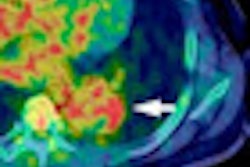A new PET imaging agent radiolabeled with the positron-emitting isotope gallium-68 is showing early success in detecting stem cell-like tumor cells in patients with breast cancer, according to a study by researchers from Texas.
If the so-called "radiolabeled hedgehog" can collaborate with PET to image certain cancer cells, researchers believe early detection may lead to aggressive treatments to minimize tumor recurrence, improve therapeutic outcome, and aid in evaluating new cancer therapies targeted at stem cells.
"The question is: How can we tell which patients have tumors that are likely to recur, preferentially before we give the initial treatment? And can we develop PET imaging agents to do this?" said Jennifer Sims-Mourtada, Ph.D., director of molecular research and development at research institute RadioMedix of Houston.
She presented results of the pilot study on behalf of her colleagues at RadioMedix and M. D. Anderson Cancer Center at the University of Texas in Houston at the recent American Association for Cancer Research (AACR) annual meeting in Washington, DC.
Stem cell hypothesis
The most prominent theory of why tumors recur is known as the cancer stem cell hypothesis. The theory is that cancer stem cells can arise from adult stem cells that acquire mutations that make the cancer cells behave more aggressively, or the cancer stem cells can arise from mature tumor cells with mutations that make the tumors act like stem cells.
Cancer stem cells, themselves, are capable of self-renewal, which means the cell can develop into a mature tissue cell. The stem cell "also has the ability to indefinitely divide into another stem cell," Sims-Mourtada explained. "So, you have an exponential propagation of cells. Because of this, cancer stem cells are known as tumor-forming cells."
Cancer stem cells also are known to be resistant to chemotherapy and radiation. Along with an abundance of drug transporters on their surface to spurn chemotherapy, cancer stem cells have DNA repair mechanisms to overcome effective radiation.
It is thought that patients who respond to chemotherapy and radiation treatment do not have these cancer stem cells in their tumors, Sims-Mourtada said. When they receive therapy, the tumor dies.
Nonresponding cells
Within nonresponding cells, there is a population of cancer stem cells that can survive chemotherapy and radiation therapy. "While you have the death of all the mature tumor cells and the tumor may even shrink or appear to go away, these cancer stem cells can repopulate the tumor and the tumor can eventually grow back," she added.
The recurrent tumors are even more resistant to therapy than the original tumors. "We believe this is because [the tumor] has a higher population of stem cells as it reoccurs," Sims-Mourtada said. "And, if you have a tumor that has reoccurred, your chances of survival are very low."
Based on that knowledge, the researchers focused their effort on imaging stem cell pathways that are known to be important for embryonic stem cells and cancer stem cells.
The pathway researchers are exploring, known as the hedgehog pathway, is responsible for the growth and survival of normal adult and embryonic stem cells. The hedgehog pathway also is activated in aggressive tumors and confers resistance to chemotherapy and radiation therapy, Sims-Mourtada said.
With the positron-emitting qualities of gallium-68, the isotope can be imaged with a standard PET camera and is produced by a generator, thus avoiding the need for a cyclotron. Gallium-68 has a half-life of approximately 68 minutes and "you can get the same quality images" as with F-18 fluoride, Sims-Mourtada added.
Radiolabeled hedgehog
So far, researchers have bound the radiolabeled hedgehog to the hedgehog receptor on the surface of breast cancer cells. "Interestingly, we see the highest uptake in the breast cancer cell lines that have the highest percentage of cells with the cancer stem cell marker," Sims-Mourtada said.
The study also has shown that the radiolabeled hedgehog can differentiate between stem cell-like cancer cells and the entire tumor population. "We believe this agent can eventually be used to identify aggressive tumors that may be rich in cancer stem cells," she added. "It also can potentially be used to assess response to cancer stem cell therapies that are very popular right now, such as hedgehog inhibitors."
The results are being validated in further laboratory work, and microPET imaging studies are under way to assess the value of this agent for imaging tumors that have high cancer stem cell populations.
Further development of the radiolabeled hedgehog depends, in part, on future funding. Sims-Mourtada said RadioMedix is actively recruiting investors, as the project to date has relied primarily on grants.
With additional funding, the researchers hope to conduct large-scale studies within the next 12 to 18 months and to be able to file a preinvestigational new drug application with the U.S. Food and Drug Administration (FDA) to commence human trials.
By Wayne Forrest
AuntMinnie.com staff writer
April 30, 2010
Related Reading
Whole-body PET better for palpable breast cancer, May 2, 2008
Whole-body FDG-PET of little use in breast cancer staging, November 26, 2006
Preop FDG-PET spots axillary involvement in breast cancer, may obviate biopsy, August 21, 2006
Dual-time-point breast PET increases diagnostic accuracy, December 2, 2005
PET mammography unit shows promise for DCIS, June 22, 2005
Copyright © 2010 AuntMinnie.com




















